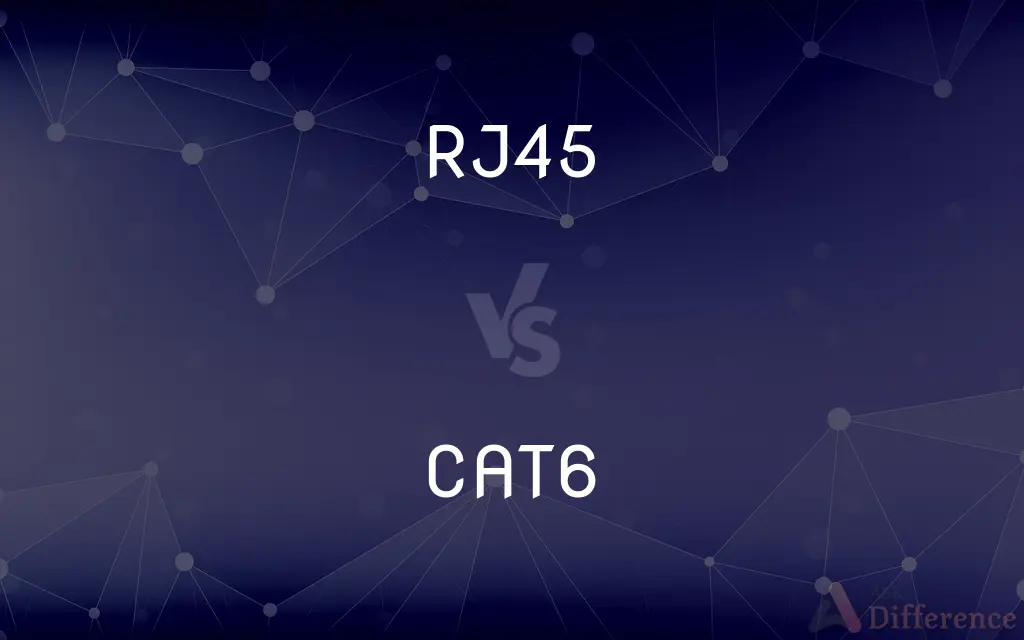RJ45 vs. CAT6 — What's the Difference?
By Fiza Rafique & Maham Liaqat — Published on February 19, 2024
RJ45 is a connector type for Ethernet cables, while CAT6 refers to a cable category with high-speed networking capabilities.

Difference Between RJ45 and CAT6
Table of Contents
ADVERTISEMENT
Key Differences
RJ45 connectors are used with various types of network cables, including CAT6, to provide physical interfaces for networking devices. The RJ45 is an 8-pin connector that is commonly used in networking environments, connecting devices like computers, routers, and switches. It's designed to work with twisted pair cables, including CAT6, which is known for its high-speed data transmission capabilities. CAT6 cables are engineered to support Gigabit Ethernet speeds up to 10 Gbps over short distances, and they use RJ45 connectors to ensure a reliable connection between devices in a network.
CAT6 cables are a category of Ethernet cabling that offers improved performance over previous categories like CAT5e. These cables are equipped with RJ45 connectors at both ends, which are standardized for easy connection to network devices. The CAT6 specification includes more stringent specifications for crosstalk and system noise, providing better reliability and speed. RJ45 connectors used with CAT6 cables must be compatible with the cable's enhanced performance to maintain the integrity of the network.
The RJ45 connector and CAT6 cable work together in network infrastructures to provide high-speed data transmission. While the RJ45 is a physical connector, CAT6 is a type of cable that specifies the level of performance. The compatibility between RJ45 connectors and CAT6 cables is crucial for achieving the optimal performance of a network setup. This ensures that data is transmitted efficiently and without interference, which is vital in modern high-speed networks.
Despite their interdependent functionality, RJ45 and CAT6 are often mistakenly used interchangeably. However, RJ45 refers specifically to the connector design, not the cable or its performance capabilities. In contrast, CAT6 describes the cable's technical specifications and performance criteria. Understanding the distinction between the two is essential for network design and troubleshooting.
RJ45 is a crucial component for connecting CAT6 cables, while the performance of a network relies on the quality of both the connectors and the cables. High-quality RJ45 connectors ensure a secure and stable connection for CAT6 cables, which are designed to support high-speed data transmission. The synergy between RJ45 connectors and CAT6 cables is fundamental to achieving efficient and reliable network performance.
ADVERTISEMENT
Comparison Chart
Definition
A type of connector for Ethernet cables.
A category of Ethernet cable with advanced specifications for network performance.
Primary Use
Connecting network devices via cables.
Transmitting data at high speeds across networks.
Compatibility
Works with various Ethernet cable categories, including CAT6.
Requires RJ45 connectors for connectivity.
Performance Focus
Provides physical connectivity; does not inherently affect speed.
Designed for minimal crosstalk and higher data transmission rates.
Physical Design
8-pin/8-position plug or jack.
Twisted pair cable with specific shielding to reduce interference.
Compare with Definitions
RJ45
Commonly used in LAN and internet connections.
A faulty RJ45 connector can disrupt your internet connection.
CAT6
Supports up to 10 Gbps over short distances.
For the new server room, only CAT6 cables were considered suitable.
RJ45
Standardized for compatibility with various Ethernet cables.
The RJ45 connectors are universal across different network setups.
CAT6
Features improved crosstalk reduction compared to older versions.
CAT6 cables ensure minimal interference in our data center.
RJ45
A connector used for Ethernet networking.
Ensure the RJ45 is securely plugged into the router.
CAT6
Suitable for Gigabit Ethernet and beyond.
Our network's backbone is built with CAT6 to future-proof our infrastructure.
RJ45
Can be used with CAT6 cables for high-speed networks.
For optimal performance, use RJ45 connectors with CAT6 cables.
CAT6
Requires RJ45 connectors for connectivity.
When terminating CAT6 cables, ensure you use high-quality RJ45 connectors.
RJ45
Features 8 pins for wire connections.
Each wire in the cable connects to a specific pin in the RJ45.
CAT6
A type of Ethernet cable designed for high-speed networks.
We upgraded to CAT6 cables for faster internet speeds.
Common Curiosities
What does CAT6 refer to?
CAT6 is a category of Ethernet cable designed for high-speed data transmission, supporting speeds up to 10 Gbps.
What is an RJ45 connector?
RJ45 is a standard type of connector used for Ethernet networking, capable of connecting devices like computers and routers.
Can RJ45 connectors be used with CAT6 cables?
Yes, RJ45 connectors are compatible with CAT6 cables and are commonly used to terminate these cables.
Is there a physical difference between RJ45 connectors for CAT6 and other categories?
While RJ45 connectors are physically similar, those used for CAT6 cables are often built to higher standards to support the cable's enhanced performance.
What are the main benefits of using CAT6 cables?
CAT6 cables offer higher bandwidth and faster data transmission rates with reduced crosstalk compared to older cable categories.
How do I know if my cable is CAT6?
CAT6 cables are typically labeled as "CAT6" along the cable sheath and have stricter specifications for crosstalk and system noise.
Can I use a CAT6 cable with any network device?
Yes, as long as the device has an RJ45 port, CAT6 cables can be used for connectivity.
Are CAT6 cables much more expensive than older categories?
CAT6 cables are generally more expensive than CAT5e due to their advanced specifications, but the cost difference has decreased over time.
Can I plug an RJ45 connector into a non-Ethernet port?
RJ45 connectors are specifically designed for Ethernet ports and may not be compatible with non-Ethernet interfaces.
Is it necessary to use CAT6 cables for home networks?
While not necessary for all home networks, CAT6 can provide improved performance for high-speed internet and data-intensive applications.
Can I use CAT6 cables outdoors?
Standard CAT6 cables are not designed for outdoor use unless specified as outdoor-rated, which have additional protection against the elements.
Do all RJ45 connectors support Gigabit Ethernet?
While RJ45 is the standard connector for Ethernet, the network speed also depends on the cable and network equipment used.
What is the maximum length for a CAT6 cable to maintain optimal performance?
The maximum recommended length is up to 100 meters (328 feet) for most applications to avoid signal loss.
Do I need special tools to connect RJ45 connectors to CAT6 cables?
Yes, crimping tools are typically required to securely attach RJ45 connectors to CAT6 cables.
Are RJ45 connectors reusable?
RJ45 connectors are not typically designed to be reusable once they have been crimped onto a cable.
Share Your Discovery

Previous Comparison
Past vs. Past Perfect
Next Comparison
Android TV vs. Google TVAuthor Spotlight
Written by
Fiza RafiqueFiza Rafique is a skilled content writer at AskDifference.com, where she meticulously refines and enhances written pieces. Drawing from her vast editorial expertise, Fiza ensures clarity, accuracy, and precision in every article. Passionate about language, she continually seeks to elevate the quality of content for readers worldwide.
Co-written by
Maham Liaqat













































